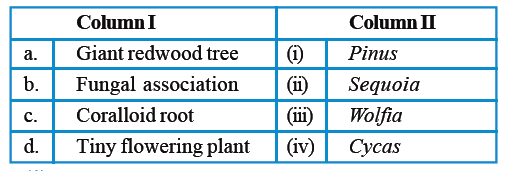Select the correct matching of animals, their symmetry, organisation and coelom type.
AnimalsSymmetryOrganisationCoelom typeCtenophoresRadialDiploblasticPseudocoelomates
AnimalsSymmetryOrganisationCoelom typeEchinodermsBilateralTriploblasticCoelomates
AnimalsSymmetryOrganisationCoelom typePlatyhelminthesBilateralTriploblasticAcoelomates
AnimalsSymmetryOrganisationCoelom typeAnnelidsBiradialDiploblasticCoelomates
The correct Answer is:C
To solve the question regarding the correct matching of animals, their symmetry, organization, and coelom type, we will analyze each option step by step.
1. Option 1: Tenophora (Sea Walnuts or Sea Jellies)
- Symmetry: Radial - True. Tenophores exhibit radial symmetry.
- Organization: Diploblastic - True. They have two germ layers (ectoderm and endoderm).
- Coelom Type: Pseudocoelomates - False. Tenophores are not pseudocoelomates; they are classified as acoelomates.
- Conclusion: This option is incorrect.
2. Option 2: Echinoderms (Starfishes)
- Symmetry: Bilateral (larvae) and Radial (adults) - False. Adults are radially symmetrical, while larvae are bilaterally symmetrical.
- Organization: Triploblastic - True. Echinoderms have three germ layers (ectoderm, endoderm, mesoderm).
- Coelom Type: Coelomates - True. Echinoderms are true coelomates.
- Conclusion: This option is incorrect due to the symmetry description.
3. Option 3: Platyhelminthes (Flatworms)
- Symmetry: Bilateral - True. Flatworms are bilaterally symmetrical.
- Organization: Triploblastic - True. They have three germ layers.
- Coelom Type: Acoelomates - True. Flatworms lack a coelom.
- Conclusion: This option is correct.
4. Option 4: Annelids (Earthworms)
- Symmetry: Biradial - False. Annelids are bilaterally symmetrical.
- Organization: Diploblastic - False. They are triploblastic.
- Coelom Type: Coelomates - True. Annelids are true coelomates.
- Conclusion: This option is incorrect due to the symmetry and organization descriptions.
Final Answer:
The correct matching of animals, their symmetry, organization, and coelom type is found in Option 3: Platyhelminthes (Flatworms).
- Symmetry: Radial - True. Tenophores exhibit radial symmetry.
- Organization: Diploblastic - True. They have two germ layers (ectoderm and endoderm).
- Coelom Type: Pseudocoelomates - False. Tenophores are not pseudocoelomates; they are classified as acoelomates.
- Conclusion: This option is incorrect.
- Symmetry: Bilateral (larvae) and Radial (adults) - False. Adults are radially symmetrical, while larvae are bilaterally symmetrical.
- Organization: Triploblastic - True. Echinoderms have three germ layers (ectoderm, endoderm, mesoderm).
- Coelom Type: Coelomates - True. Echinoderms are true coelomates.
- Conclusion: This option is incorrect due to the symmetry description.
- Symmetry: Bilateral - True. Flatworms are bilaterally symmetrical.
- Organization: Triploblastic - True. They have three germ layers.
- Coelom Type: Acoelomates - True. Flatworms lack a coelom.
- Conclusion: This option is correct.
- Symmetry: Biradial - False. Annelids are bilaterally symmetrical.
- Organization: Diploblastic - False. They are triploblastic.
- Coelom Type: Coelomates - True. Annelids are true coelomates.
- Conclusion: This option is incorrect due to the symmetry and organization descriptions.
The correct matching of animals, their symmetry, organization, and coelom type is found in Option 3: Platyhelminthes (Flatworms).
Topper's Solved these Questions
- BOOK - NCERT FINGERTPS ENGLISHCHAPTER - ANIMAL KINGDOMEXERCISE - Classification of non-chordates41videos
ANIMAL KINGDOM
- BOOK - NCERT FINGERTPS ENGLISHCHAPTER - ANIMAL KINGDOMEXERCISE - Classification of chordates62videos
ANIMAL KINGDOM
- BOOK - NCERT FINGERTPS ENGLISHCHAPTER - ANATOMY OF FLOWERING PLANTSEXERCISE - Anatomy Of Flowering Plants143videos
ANATOMY OF FLOWERING PLANTS
- BOOK - NCERT FINGERTPS ENGLISHCHAPTER - BIOLOGICAL CLASSIFICATIONEXERCISE - Biological Classification132videos
BIOLOGICAL CLASSIFICATION
Similar Questions
Select a correct match:
View SolutionSelect a correct match
View SolutionSelect a correct match
View SolutionSelect out the correct match
View SolutionSelect correct matching :-
View SolutionSelect correct match :
 View Solution
View SolutionSelect correct match:
 View Solution
View SolutionSelect the correct matched pair
View SolutionSelect the correct matched pair
View SolutionSelect correct match
 View Solution
View Solution

